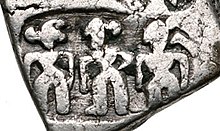Ekanamsha
Ekanamsha (Sanskrit: एकानंशा, Ekānaṁśā) is a Hindu goddess, identified with Yoganidra a.k.a. Yogmaya. In Sanskrit, Ekanamsha means "the single, portionless one" and it is a name of the new moon.[3] The Goddess also means she who grants wishes within a minute. Ekanamsha devi granted her devotee Devaki wish of deafeating kamsa by cursing him to die by hands of lord Vishnu.The Indian Theogony: According to S. C. Mukherji, a modern scholar, in the Harivamsa, Ekanamsha is identified as a shakti of Vishnu like Ekadasi devi, she descended as the daughter of Nanda to protect the baby Krishna from Kamsa.[4] In Harivamsa, she is represented as sister of Indra Vishnu due to which she is also known as Vimala devi, Devi Yogamaya, Subhadra (wife of Arjuna). Visnudharmottara purana describes her as Gandhari (power of illusion pertaining to Vishnu) and this Gandhari represents Dhrti, Kirti, Pusti, Sraddha, Sarasvati, Gayatri and Kalaratri. she was worshipped by the Vrishnis.[5] Many "kinship triads", depicting Vasudeva Krishna, Balarama and their sister Ekanamsha have been found in the Mathura region, which are stylistically dated to the early centuries of the Common era.[6] She reincarnated as goddess Subhadra, daughter of Vasudeva and Rohini.
According to the Brahmavaivarta Purana, Ekanamsha was the daughter of Nanda and Yashoda who was taken away by Vasudeva. When Kamsa tried to kill her she transformed into the goddess - Durga/Yogamaya. Though in other versions the baby girl is deported to Vindhya Mountains, in this Puranic version she stays with Vasudeva and Devaki. Later when Krishna marries Rukmini, she was sent with Durvasa to protect and help him.[7]
References[]
- ^ Paul, Pran Gopal; Paul, Debjani (1989). "Brahmanical Imagery in the Kuṣāṇa Art of Mathurā: Tradition and Innovations". East and West. 39 (1/4): 116–117. ISSN 0012-8376. JSTOR 29756891.
- ^ Gupta, Vinay K. "Vrishnis in Ancient Literature and Art". Indology's Pulse Arts in Context, Doris Meth Srinivasan Festschrift Volume, Eds. Corinna Wessels Mevissen and Gerd Mevissen with Assistance of Vinay Kumar Gupta: 70–72.
- ^ Hawley, John Stratton and Donna Marie Wolf (1986) (ed.) The Divine Consort: Rādhā and the Goddesses of India, Boston: Beacon Press, ISBN 0-8070-1303-X, p.372
- ^ Hudson, Dennis (1986) Piņņai, Krishna's Cowherd Wife in John Stratton Hawley and Donna Marie Wolf ed. The Divine Consort: Rādhā and the Goddesses of India, Boston: Beacon Press, ISBN 0-8070-1303-X, p.256
- ^ Bhattacharji, Sukumari (2000).The Indian Theogony: Brahmā, Viṣṇu and Śiva, New Delhi: Penguin, ISBN 0-14-029570-4, p.173
- ^ Singh, Upinder (2008). A History of Ancient and Early Medieval India: From the Stone Age to the 12th Century. Delhi: Pearson Education. pp. 436–7. ISBN 978-81-317-1677-9.
- ^ Brahmavaivarta Purana Sri-Krishna-Janma Khanda (Fourth Canto) 7th Chapter English translation by Shantilal Nagar Parimal Publications Link: https://archive.org/details/brahma-vaivarta-purana-all-four-kandas-english-translation
- Hindu goddesses
- People related to Krishna

